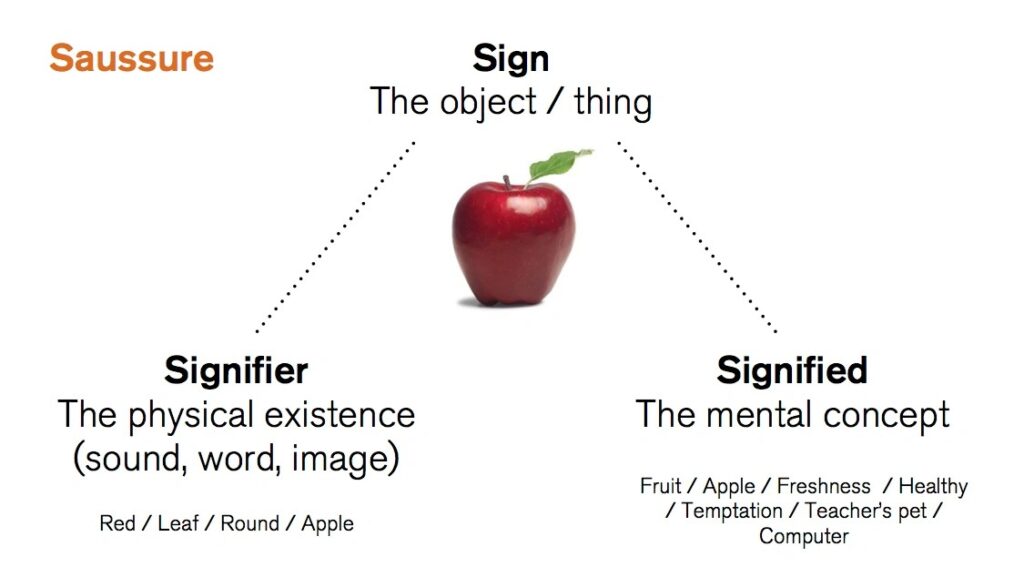
Page Contents
Introduction
Linguist and semiotics godfather Ferdinand de Saussure said they are “the plane of expression” and “the plane of content,” respectively. Together, they create the sign or literal meaning. (“Semiotics” comes from the Greek “semio,” meaning “of signs.”)
It is a well-known fact that we, on a subconscious level, form perceptions and emotions that drive our purchases. This is where semiotics come into the picture.
Extensive research in this field finds and brings out areas for consumer creativity, cultural innovation, and new market opportunities.
What is semiotics?
Semiotics is the study of signs and symbols. It explains meaning through our social and cultural background, revealing how we interpret messages instinctively.
As a hybrid of communication science and anthropology, semiotics accounts for the cultural practices that define brand meaning, consumer rituals, and the social aspect of the organization.
It also provides access to the cultural norms and structural values relevant to the market. They are also used to understand the perception of value in marketing.
Simply put, Semiotics is the study of how an idea or object communicates the associated meaning and what message it communicates.
For example, “coffee” is a beverage, but it also signals comfort, alertness, creativity and countless other associations.
Semiotic in Marketing
Practical Semiotics presents a client with the most notable examples. It incorporates AI-enabled social-media listening and meticulous analysis of important factors, even the font size or positioning of visual elements.
For this to be credible, semiotics has to combine its findings from a broad array of sources of knowledge.
A range of expertise is critical, with the help of a team of specialists. They would be psychologists, art-history experts, and the cultural-linguistics authority. It’s all about well-rounded observation and analysis, not some glorified test.
We should keep in mind that marketing semiotics is not an elixir. It is one of the powerful tools that include sophisticated data-driven marketing, neuroscience awareness, and qualitative consumer research.
Apple is a great example of a brand that has an unrivaled identity. People don’t just queue for hours to buy smartphones or laptops, they rather queue to buy status and a specific lifestyle.
Apple sells those attributes as much as it sells hardware. Company’s messaging had already gone through such filters and reaches straight into consumers’ subconscious.
As we know, marketing is communicating the correct message at the opportune time and to the right target audience. Customers are not just buying a physical product or service from us, they buy comfort or a product that matches their image and needs.
Importance of Semiotics
Improve brand messaging.
This is all about communicating the meaning of the brand, service, or product. It influences customers’ subconscious decision-making. Using cultural messages to improve localized marketing strategies.
A message appropriate in one geography might be awkward in another, because of cultural differences.
Semiotics can take multiple forms, not just visual. We think about it by using and utilizing the body’s five senses — sight, sound, taste, smell, and touch.
By applying correctly, semiotics gives power to marketers to create better advertisements, websites, social media content and engagement, shop design, and merchandise.
It is an indispensable means for improving marketing output and also gaining wisdom in understanding consumer behavior.
it is a great technique for companies and brands to understand how consumers perceive their products and services. This helps in growing their brand.
We should keep in mind that not everyone assumes a symbol the same way. It is important to remember the culture and its context. They play a big part in how symbols are understood and interpreted.
So the research process should always be inclusive of this factor. They need to be conducted thoroughly to understand how our chosen symbol is going to be interpreted.
Our subconscious interpretations rely on emotions, not information. Psychologist Daniel Kahneman calls it the preponderance of System 1 (emotional) over System 2 (rational) in the human brain.
Although we might think it’s System 2 that helps us make rational decisions, it’s not so. Emotional System 1 calls the shots here: it’s the source of our beliefs, and it deliberates all rational choices of System 2.
The surrounding environment influences our feelings and impressions. Especially by all the non-verbal symbols that our brain interprets, packages, and extracts meaning from them.
This powerful but invisible communication is exactly what semiotics can help marketers to understand their market and consumers alike.
Importance of semiotic analysis
To persuade
Words, images, sounds, gestures, and objects are all signs that can be interpreted. A semiotic analysis helps interpret each one of them. And then employ that information later to persuade consumers.
Each sign consists of two parts:
Signifier – The form it takes.
Signified – The concept it represents.
Also, semiotic analysis has three steps:
Analyze verbal signs (what you observe and hear).
Analyze visual signs (what you see).
Analyze the symbolic message (interpretation of what you see).
An apt example – “a glass half full” is perceived as a sign of optimism and positiveness.
Here, the signifier is a glass that is half full but most importantly, the signified is “Optimism”
So, semiotic analysis decodes the meanings or cues that resonate with the target audience. With that insight, one can mix the decoded elements into the brand and throughout the marketing communications. Results in better customer engagement.

A semiotic analysis should be part of a checklist when developing a new ad campaign or publishing, related content.
We can run the analysis ourselves or with our marketing team. Even better would be to invite representatives from other departments or, focused groups or from some of the target audience.
Creating a positive ideology for the brand.
Ethos is “the fundamental character or spirit of a culture; the underlying sentiment that informs the belief, customs, or practices of a group or society.”
The quality of your product and your attitude toward customer service are two core elements of the brand ethos. From a semiotics perspective, your ethos succeeds when you stand for what your claim matches your brand’s behavior.
Today, many companies have focused on two aspects: environmental sustainability and social responsibility.
Forrester notes that more than half of U.S. shoppers “not only reject corporate irresponsibility but also seek brands that proactively promote beliefs and values aligned with their own.”
How to perform Semiotic analysis
Qualitative research is the most used and important approach in semiotic analysis.
Open-ended questions
Collect as many interpretations as possible via surveys or interviews. Identify the prominent interpretation and verify if it aligns with the meaning you intend to communicate.
Abstract questions
We should try to explore hidden meanings behind symbols to see if we have missed alternative interpretations. Focus groups or brainstorming sessions with the team will help substantially here.
Probing questions
Try to rework an answer and extrapolate further. If we say that squares make a logo look structured. The immediate probing question would be to ask someone to explain the connection between a square and a structure.
Projective techniques
The psychological attitudes of the audience are a critical component. For example, if we want to understand whether our company’s logo is youthful, we should ask a group comprising youths to interpret it. We can also try word associations and images to try here.
To identify the signified factors, there is no fixed number of questions to ask about the messages. We can begin with the above three, then develop more related sub-questions.
Example –
What does the text reveal? what is the tone? Will my headline grab attention? What does it signal about my product/service? Does it convey the intended emotions behind it? How does it relate to the images?
What does the image reveal? Is it attention-grabbing? How does it relate to the text?
Who is the target market? Does the message address their age, income level, pain points, views, and culture? Which elements highlight this?
Here’s a semiotic interpretation of a Heinz ad:

(cxl.com)
Semiotics and brand identity.
Symbolic elements such as brand logo, brand colors, text content, advertisements, cultural symbols, website, and the physical environment of your brand collectively give a signal to end-users.
Consider the psychological and emotional associations of colors when choosing a palette to communicate corresponding meanings to the audience.
People associate Red with Coca-Cola and Blue with Pepsi often.
The shape of the logo has a semiotic meaning, too.
Several studies have been done and they call a logo “the most essential semiotic mediator for meaning within a corporation’s verbal and visual marketing strategies.”
Take, for example, circles. They communicate friendship, unity, and warmth. A sense of togetherness. It’s exactly what Pepsi’s logo suggests to consumers: engaging, dynamic, and alive. It “smiles” at people with the curved white stripe through the circle.
Research says that symbols like squares project power and professionalism—lines are for strength and tranquillity. The Mitsubishi Motors logo is a perfect demonstration of semiotics’ power, symbolizing strength, professionalism, and quality.
Similarly, there is a psychology behind fonts too. The connotations of fonts should project the brand’s verbal identity—the slogan and language used to communicate a message in taglines, ads, brand voice, and tone.
For example, a font like Comic Sans, for example, would be the wrong choice for say Mayo Clinic.
Another great example is Android’s slogan, “be together. not the same.”.
It projects the power of the community. The brand has a mission of being universally accessible and an enabler to unite diverse people.
Similarly, Dollar Shave Club’s slogan. “Shave time. Shave money.” It emphasizes the playful and informal approach of the brand.
We should also consider our brand’s behavioral identity. How it is supposed to interact with consumers and creates experiences around their needs and desires.
In 2020, the game Pokemon Sleep was launched. It said – “give players a reason to look forward to waking up in the morning. ” Your sleep will affect gameplay, turning a physical need into entertainment.
The three attributes are visual, verbal, and behavioral, which have a profound semiotic connection with the audience on different levels. Adidas incorporates all three into this ad:

(cxl.com)
Visual identity – Adidas evokes its three stripes with bandages on a player’s foot. The visual subtly signal the value Adidas provides. Fake products offer a contradictory and painful version of the famous stripes.
Verbal identity – With the phrase “fake hurt real,” Adidas connects the pain of a foot injury with the financial pain they endure from counterfeit products.
Behavioral identity – Adidas positions itself as the protector of the athlete, keeping safe from counterfeiters who don’t deliver quality or care about your well-being.
Semiotics and the meaning of signs, codes, and images.
Signs
“father” of semiotics, Charles Sanders Peirce said, “We think only in signs.”
It’s clear that the apple is a core sign. In some cultures, it’s interpreted as the symbol of temptation and sin. Here we get the cultural reference to Adam and Eve’s archetypal story.
So we see how just one apple can build a narrative filled with meanings.
The narrative binds viewers by focusing on symbols and archetypes. Most consumers can’t explain why they want to buy a certain perfume. Semiotics could.
Codes
The cultural code defines how sets of images connect to our stereotypes. For example, an ad from Dior. It taps into a classic “luxury” code-heavy baroque architecture, lots of gold, massive chandeliers, etc.
Conclusion
We humans most of the time make emotional decisions. And the subconscious often guides those emotions, which interpret words and images.
Semiotics help decodes those subconscious messages to further polish the messaging and branding.
An opportunity at every instance to make my product or services better. With time and practice, we get a better idea of how the audience understands the projection.
In summary, it is an excellent tool, if applied correctly has the power to provide a competitive advantage.